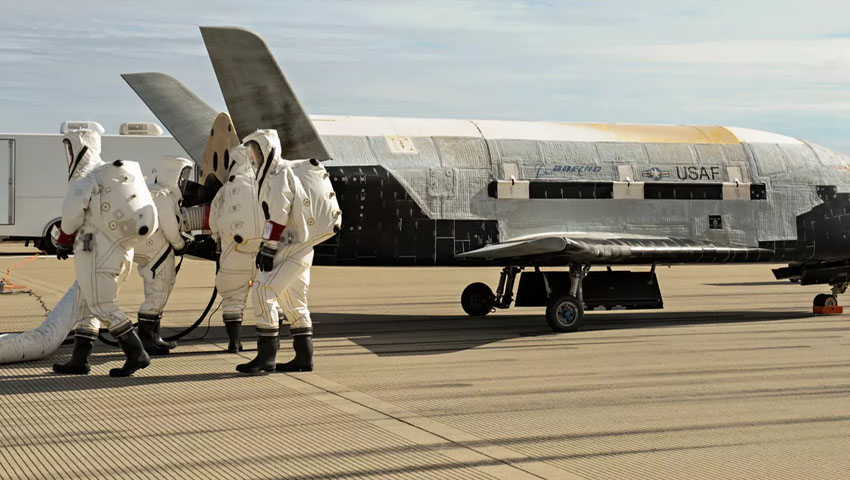It may be a far cry from the USS Enterprise of Captain Kirk, but the recent capture of images of the secretive Boeing designed X-37B space plane raises questions about the continuing pacification of space and the path forward for Australia in the final frontier.
To continue reading the rest of this article, please log in.
Create free account to get unlimited news articles and more!
The increasing dependence and vulnerability of space-based intelligence, surveillance and communications assets, combined with the ever-advancing pace of anti-satellite technology, is opening avenues for Australia to leverage domestic expertise to develop a credible, cost-effective ‘multi-domain’ force multiplying space-based capability.
However, the militarisation of space has long been a contentious issue with many nations, including the US, Russia and China actively pursuing the militarisation of the space, with systems ranging from largely defensive in nature, to intelligence gathering satellites, communications and more directly in recent decades, increasingly capable anti-space systems, highlighting the vulnerability of contemporary economies, militaries and governments.
This vulnerability is not unique to Australia and its period of modernisation and capability development – rather, every modern military, including those of major powers like the US, Russia, China and India, are all equally dependent upon the uncontested access to their own integrated space-based communications, intelligence and surveillance networks.
Recognising this, each of these powers have begun to heavily invest in both 'hard' and 'soft' kill methods for leveraging these vulnerabilities – in conjunction with advanced space situational awareness (SSA) capabilities – to protect their own vulnerable assets in the face of a simmering global space-arms race. Australia's strategic benefactor, the US has long been engaged in the development of these capabilities and platforms, most recently the X-37B has been revealed as a next-generation space capability.
Research vehicle or top secret weapons system?
The US has long been a world leader in space-based systems and platforms – the recent civilian sighting of the otherwise top secret X-37B has raised renewed questions, first asked during the revelation of the Reagan administration's Strategic Defense Initiative (SDI), how far is too far when it comes to the militarisation of space?
While the nature of the capabilities and role of the X-37B platform remains secretive and hidden behind Boeing's description of the platform, which describes the Orbital Test Vehicle as:
"The X-37B is one of the world’s newest and most advanced re-entry spacecraft, designed to operate in low-Earth orbit, 150 to 500 miles above the Earth. The vehicle is the first since the Space Shuttle with the ability to return experiments to Earth for further inspection and analysis. This United States Air Force unmanned space vehicle explores reusable vehicle technologies that support long-term space objectives."
The exact details of the space plane’s dimensions are known: It’s small, about 8.8 metres (29 feet) long, with a cargo bay not much bigger than a standard ute. Project officials have revealed that the X-37B’s manoeuvring engine runs on hydrazine and nitrogen tetroxide, and that it uses a different kind of thermal protection than NASA’s original space shuttles did – additionally, the X-37B has a prodigious operational time frame, with the duration of the first three missions revealed to the public, ranging from 224-674 days.
Despite assertions to being a research vehicle and platform for supporting experiments conducted by NASA, DARPA and the US Air Force – the secretive nature of operations conducted by the X-37B continues to raise questions, not just about the militarisation of space, but also about what capabilities remain to be developed and capitalised upon as force multipliers for nation's like Australia.
Force multipliers and opportunities for collaboration
While Australia's expertise in space situational awareness (SSA), ranging from electro-optic to laser-based platforms, phased array radars, space observation and increasingly, hypersonics position the nation well to take advantage of the rapid evolution in space-based systems – Australia's natural and continuing advantage in autonomous systems, advanced manufacturing and materials engineering further support the development of these systems.
Australia's world leading universities, combined with the continuing push by the Australian government towards developing a robust and globally competitive defence industry, supporting the development of leading-edge space-based systems as part of the broader space industry capability programs are attractive options for global aerospace companies, like Lockheed Martin, Boeing, Northrop Grumman and space companies like SpaceX, Blue Origin and Virgin Galactic.
The opportunity for combined economic, strategic and research and development capabilities enhances Australia's position as a space power – and should serve as a critical component in the Australian government's focus on developing a leading-edge space capability by combining the nation's existing and growing areas of natural comparative advantage with the drive of global collaborators to support economic and strategic objectives in the new space race.
Australia's expertise in developing hypersonics, combined with the development of an integrated fifth-generation force on the back of the F-35, provides additional 'last resort' avenues for the nation to develop leading-edge technologies, approaches and doctrines for leveraging the 'hard kill' vulnerabilities of potential adversaries.
Let us know your thoughts in the comments section below, or get in touch with
Stephen Kuper
Steve has an extensive career across government, defence industry and advocacy, having previously worked for cabinet ministers at both Federal and State levels.

 Login
Login








